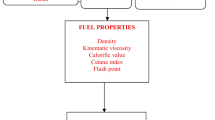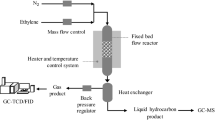Abstract
This study investigated the potential use of waste cooking oil (WCO) in the production of engine fuels and valuable chemicals via catalytic cracking. WCO was processed in its pure form and in a mixture with hydrotreated vacuum gas oil (HVGO). Catalytic cracking experiments were performed using a microactivity test (MAT) (simulation of the fluid catalytic cracking environment). In cracking over the standard fluid catalytic cracking equilibrium catalyst (FCC-ECAT), the oxygen contained in the feed was consumed in the formation of CO and CO2, water and into oxygenated organic compounds (phenolics, esters, carboxylic acids, etc.), which were found in the organic phase of the liquid product. In order to remove the unwanted organic oxygenates, the catalytic system based on pure FCC-ECAT was modified by addition of the ZSM-5-based FCC catalyst. By using the mixture containing FCC-ECAT and 10 mass % of FCC-ZSM-5, it was possible to reduce the amount of organic oxygenates to almost the feasible minimum when cracking pure WCO. The effect of the catalyst mixture on cracking the feed mixture of the vacuum gas oil with 10 vol. % of WCO was manifested in the practically zero formation of organic oxygenates and in a gasoline yield comparable with vacuum gas oil (VGO) cracking.
Similar content being viewed by others
References
ASTM International (2011). Standard test method for boiling point distribution of samples with residues such as crude oils and atmospheric and vacuum residues by high temperature gas chromatography. ASTM D7169-11. West Conshohocken, PA, USA: ASTM International.
ASTM International (2013). Standard test method for testing fluid catalytic cracking (FCC) catalysts by microactivity test. ASTM D3907-13. West Conshohocken, PA, USA: ASTM International.
Bezergianni, S., Voutetakis, S., & Kalogianni, A. (2009). Catalytic hydrocracking of fresh and used cooking oil. Industrial & Engineering Chemistry Research, 48 8402–8406. DOI: 10.1021/ie900445m.
Bezergianni, S., Dimitriadis, A., & Chrysikou, L. P. (2014). Quality and sustainability comparison of one- vs. two-step catalytic hydroprocessing of waste cooking oil. Fuel, 118 300–307. DOI: 10.1016/j.fuel.2013.10.078.
Bielansky, P., Weinert, A., Schönberger, C., & Reichhold, A. (2011). Catalytic conversion of vegetable oils in a continuous FCC pilot plant. Fuel Processing Technology, 92 2305–2311. DOI: 10.1016/j.fuproc.2011.07.021.
Bozbas, K (2008). Biodiesel as an alternative motor fuel: Production and policies in the European Union. Renewable and Sustainable Energy Reviews, 12 542–552. DOI: 10.1016/j.rser.2005.06.001.
Chen, G., Liu, C., Ma, W., Zhang, X., Li, Y., Yan, B., & Zhou, W. (2014). Co-pyrolysis of corn cob and waste cooking oil in a fixed bed. Bioresource Technology, 166 500–507. DOI: 10.1016/j.biortech.2014.05.090.
Demirbas, A. (2007). Progress and recent trends in biofuels. Progress in Energy and Combustion Science, 33 1–18. DOI: 10.1016/j.pecs.2006.06.001.
Deshpande, D. P., Urunkar, Y. D., & Thakare, P. D. (2012). Production of biodiesel from castor oil using acid and base catalysts. Research Journal of Chemical Sciences, 2 51–56.
Dias, J. M., Machado Alvim-Ferraz, M. C., Fonseca Almeida, M., Méndez Díaz, J. D., Sánchez Polo, M., & Rivera Utrilla, J. (2013). Biodiesel production using calcium manganese oxide as catalyst and different raw materials. Energy Conversion and Management, 65 647–653. DOI: 10.1016/j.enconman.2012.09.016.
Doronin, V. P., Potapenko, O. V., Lipin, P. V., & Sorokina, T. P. (2013). Catalytic cracking of vegetable oils and vacuum gas oil. Fuel, 106 757–765. DOI: 10.1016/j.fuel.2012.11.027.
Dupain, X., Costa, D. J., Schaverien, C. J., Makkee, M., & Moulijn, J. A. (2007). Cracking of rapeseed vegetable oil under realistic FCC conditions. Applied Catalysis B: Environmental, 72 44–61. DOI: 10.1016/j.apcatb.2006.10.005.
EIA (2015). Petroleum & other liquids. Report on the consumption of petroleum products in the U.S. Washington, DC, USA: U.S. Energy Information Administration. Retrieved March 5, 2015 from http://www.eia.gov/petroleum/data.cfm#consumption and http://www.eia.gov/dnav/pet/pet_cons_psup_dc_nus_mbbl_m.htm.
Fortes, I. C. P., & Baugh, P. J. (2004). Pyrolysis-GC/MS studies of vegetable oils from Macauba fruit. Journal of Analytical and Applied Pyrolysis, 72 103–111. DOI: 10.1016/j.jaap.2004.03.005.
Horňáćek, M., Hudec, P., Nociar, A., Smiešková, A., & Jakubík, T. (2010). Activity and regenerability of dealuminated zeolite Y in liquid phase alkylation of benzene with 1-alkene. Chemical Papers, 64 469–474. DOI: 10.2478/s11696-010-0030-x.
ISO (1978). Determination of water — Karl Fischer method (General method). ISO 760: 1978. Geneva, Switzerland: International Organization for Standardization.
ISO (1987). Water for analytical laboratory use — Specification and test methods. ISO 3696: 1987. Geneva, Switzerland: International Organization for Standardization.
Kunkes, E. L., Simonetti, D. A., West, R. M., Serrano-Ruiz, J. C., Gärtner, C. A., & Dumesic, J. A. (2008). Catalytic conversion of biomass to monofunctional hydrocarbons and targeted liquid-fuel classes. Science, 322 417–421. DOI: 10.1126/science.1159210.
Lappi, H., & Alén, R. (2011). Pyrolysis of vegetable oil soaps—Palm, olive, rapeseed and castor oils. Journal of Analytical and Applied Pyrolysis, 91 154–158. DOI: 10.1016/j.jaap.2011.02.003.
Li, L., Quan, K., Xu, J., Liu, F., Liu, S., Yu, S., Xie, C., Zhang, B., & Ge, X. (2013). Liquid hydrocarbon fuels from catalytic cracking of waste cooking oils using basic mesoporous molecular sieves K2O/Ba-MCM-41 as catalysts. ACS Sustainable Chemistry & Engineering, 1 1412–1416. DOI: 10.1021/sc4001548.
Li, L., Quan, K., Xu, J., Liu, F., Liu, S., Yu, S., Xie, C., Zhang, B., & Ge, X. (2014). Liquid hydrocarbon fuels from catalytic cracking of rubber seed oil using USY as catalyst. Fuel, 123 189–193. DOI: 10.1016/j.fuel.2014.01.049.
Lovás, P., Hudec, P., Hadvinová, M., & Ház, A. (2015). Conversion of rapeseed oil via catalytic cracking: Effect of the ZSM-5 catalyst on the deoxygenation process. Fuel Processing Technology, 134 223–230. DOI: 10.1016/j.fuproc.2015.01.038.
Melero, J. A., Clavero, M. M., Calleja, G., Garcia, A., Miravalles, R., & Galindo, T. (2010). Production of biofuels via the catalytic cracking of mixtures of crude vegetable oils and nonedible animal fats with vacuum gas oil. Energy & Fuels, 24 707–717. DOI: 10.1021/ef900914e.
Ooi, Y. S., Zakaria, R., Mohamed, A. R., & Bhatia, S. (2005). Catalytic conversion of fatty acids mixture to liquid fuel and chemicals over composite microporous/mesoporous catalysts. Energy & Fuels, 19 736–743. DOI: 10.1021/ef049772x.
Phan, N. A., & Phan, T. M. (2008). Biodiesel production from waste cooking oils. Fuel, 87 3490–3496. DOI: 10.1016/j.fuel.2008.07.008.
Romaní, A., Ruiz, H. A., Pereira, F. B., Teixeira, J. A., & Domingues, L. (2014). Integrated approach for effective bioethanol production using whole slurry from autohydrolyzed Eucalyptus globulus wood at high-solid loadings. Fuel, 135 482–491. DOI: 10.1016/j.fuel.2014.06.061.
Sadeghbeigi, R. (2000). FCC catalysts. In R. Sadeghbeigi, Fluid catalytic cracking handbook: Design, operation and troubleshooting of FCC facilities (2nd ed., Chapter 3, pp. 84–124). Woburn, MA, USA: Butterworth-Heinemann. DOI: 10.1016/b978-088415289-7/50004-4.
Shin, H. Y., Lim, S. M., Kang, S. C., & Bae, S. Y. (2012). Statistical optimization for biodiesel production from rapeseed oil via transesterification in supercritical methanol. Fuel Processing Technology, 98 1–5. DOI: 10.1016/j.fuproc.2012.01.025.
Sindhu, R., Kuttiraja, M., Binod, P., Janu, K. U., Sukumaran, R. K., & Pandey, A. (2011). Dilute acid pretreatment and enzymatic saccharification of sugarcane tops for bioethanol production. Bioresource Technology, 102 10915–10921. DOI: 10.1016/j.biortech.2011.09.066.
Singhabhandhu, A., & Tezuka, T. (2010a). Prospective framework for collection and exploitation of waste cooking oil as feedstock for energy conversion. Energy, 35 1839–1847. DOI: 10.1016/j.energy.2010.01.004.
Singhabhandhu, A., & Tezuka, T. (2010b). The waste-to-energy framework for integrated multi-waste utilization: Waste cooking oil, waste lubricating oil, and waste plastics. Energy, 35 2544–2551. DOI: 10.1016/j.energy.2010.03.001.
Talebian-Kiakalaieh, A., Amin, N. A. S., & Mazaheri, H. (2013). A review on novel processes of biodiesel production from waste cooking oil. Applied Energy, 104 683–710. DOI: 10.1016/j.apenergy.2012.11.061.
Taufiqurrahmi, N., Mohamed, A. R., & Bhatia, S. (2011). Production of biofuel from waste cooking palm oil using nanocrystaline zeolite as catalyst: Process optimization studies. Bioresource Technology, 102 10686–10694. DOI: 10.1016/j.biortech.2011.08.068.
Triantafillidis, C. S., & Evmiridis, N. P. (1999). Performance of ZSM-5 as a fluid catalytic cracking catalyst additive: Effect of the total number of acid sites and particle size. Industrial & Engineering Chemistry Research, 38 916–927. DOI: 10.1021/ie980395j.
Twaiq, F. A. A., Mohamad, A. R., & Bhatia, S. (2004). Performance of composite catalyst in palm oil cracking for the production of liquid fuels and chemicals. Fuel Processing Technology, 85 1283–1300. DOI: 10.1016/j.fuproc.2003.08.003.
Velmurugan, R., & Muthukumar, K. (2011). Utilization of sugarcane bagasse for bioethanol production: Sono-assisted acid hydrolysis approach. Bioresource Technology, 102 7119–7123. DOI: 10.1016/j.biortech.2011.04.045.
Vu, H. X., Schneider, M., Bentrup, U., Dang, T. T., Phan, B. M. Q., Nguyen, D. A., Armbruster, U., & Martin, A. (2015). Hierarchical ZSM-5 materials for an enhanced formation of gasoline-range hydrocarbons and light olefins in catalytic cracking of triglyceride-rich biomass. Industrial & Engineering Chemistry Research, 54 1773–1782. DOI: 10.1021/ie504519q.
Author information
Authors and Affiliations
Corresponding author
Rights and permissions
About this article
Cite this article
Lovás, P., Hudec, P., Hadvinová, M. et al. Use of ZSM-5 catalyst in deoxygenation of waste cooking oil. Chem. Pap. 69, 1454–1464 (2015). https://doi.org/10.1515/chempap-2015-0159
Received:
Revised:
Accepted:
Published:
Issue Date:
DOI: https://doi.org/10.1515/chempap-2015-0159




